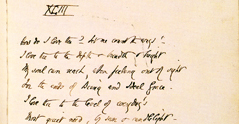GOTHIC FICTION
Rare Printed Works from the Sadleir-Black collection of Gothic Fiction
at the Alderman Library, University of Virginia
Part 1: Matthew Lewis and Gothic Horror - Beckford to Lewis
Frederick S. Frank
Professor Emeritus of English, Allegheny College, Pennsylvania
(see Professor Frank's website, The Sickly Taper, and his essay on the Sadleir-Black Collection, Gothic Gold)
"The collection is of unique interest, and should have a ready sale to universities that lack the resources here. Gothic studies are increasingly popular with students and yet the texts beyond the most famous writers are extremely rare and hard to come by."
Alison Milbank
Consultant Editor, Department of English, University of Virginia "An exciting project that will find a large and appreciative audience."
Peter Otto
Consultant Editor, Department of English, University of Melbourne "There is a resurgence of interest in Gothic Literature. For a variety of Gothic material to be available in microform will appeal not only to Gothic enthusiasts, but also to students and researchers in history, literary studies and gender studies."
Marie Mulvey-Roberts
Consultant Editor, Department of Literary Studies,
University of the West of England Gothic Fiction has exerted a powerful influence over popular culture. From Prince Manfred to Buffy the Vampire Slayer, and from Anne Radcliffe to Anne Rice, tales of terror have been eagerly embraced by the public. But while such texts have been popular, they have also been marginalised by critics. Current challenges to the hierarchies of literary value suggest that Gothic Fiction deserves a more central position. To fuel this debate and to serve the increasing number of Gothic courses now springing up we offer access to one of the most important libraries of Gothic Literature in the world - the Sadleir-Black Collection of Gothic Fiction at the University of Virginia. The Sadleir-Black Collection originated from the efforts of the bibliographer and book collector Michael Sadleir whose passion for the Gothic stemmed from his studies of Edgar Allen Poe and his interest in the Northanger novels. "The lust for Gothic romance took complete possession of me", he admitted. He built up a considerable Gothic Library by trawling through rare and second hand bookshops, but his holdings were considerably expanded when he was made heir and executor of Arthur Hutchinson, conversationalist, clubman and bibliomaniac. Hutchinson filled 140 packing cases with all manner of eighteenth and nineteenth century fiction, paying more attention to the wrappers and spines of the books than their content. His holdings of shilling shockers and multipart Gothic novels were very strong, and scholars continue to benefit from the fine condition of his volumes. Sadleir's collection now ran to nearly 1,000 volumes and all it lacked was a permanent home. That problem was solved by Robert Kerr Black, who had been introduced to Gothic Literature at the University of Virginia by Professor Archibald Shepperson. Black was also a book collector and had amassed a fine collection of burlesque novels including many parodies of Gothic fiction. Black's interest in collecting Gothic literature coincided with Sadleir's switch of interest to the Trollopes and Victorian Fiction. Black expanded and refined the collection, filling obvious gaps such as Beckford's Vathek and Shelley's Frankenstein and adding Rosicrucian novels and works of writers such as Maturin. He also added some important manuscripts such as Anne Radcliffe's contract for Udolpho. In 1942 the Sadleir-Black Collection was given to the University of Virginia where it remains today. The diversity and scope of the collection make it an extremely important source for anyone interested in Gothic fiction and popular culture. It ranges from front rank authors of the genre such as Radcliffe, Lewis and Maturin, to shudder novels, miscellanies, annuals and keepsakes. Authors such as Charlotte Dacre, W H Ireland, Elizabeth Holme, Mary Meeke, George Moore and Mary Robinson are also well represented, enabling scholars to explore the development of the genre. The aim of this microfilm project is to make available a wide variety of these works, placing a special emphasis on material that is extremely rare or difficult to consult. To bring this within the compass of most libraries this has been divided into a number of thematic groupings, covering: - Gothic Horror: Lewis and his followers
- Gothic Terror: Radcliffe and her imitators
- Early Gothic: Sentiment, Romance and the 'unspeakable'
- Gothic History, Chap books and Melodramas Each part will comprise around 40 titles including key canonical works in first and variant editions as well as many lesser known works. Some of the titles that will be included are: - Regina Maria Roche, The houses of Osma and Almeira; or, Convent of St Ildefenso. A tale (1810)
- Charlotte Dacre, Zofloya; or, The Moor: A romance of the fifteenth century (1806)
- Sophia L Francis, the nun of Miserecordia; or, The eve of All Saints. A romance (1807)
- W H Ireland, The abbess, a romance (1799)
- George Walker, the three spaniards. A romance (1800)
- Anthony Frederick Holstein, Love, mystery, and misery! A novel (1810)
- Mrs Isaacs, Ariel, or the invisible Monster (1801)
- Regina Maria Roche, Clermont, a tale (1798)
- Regina Maria Roche, The children of the abbey. A tale (1796)
- Regina Maria Roche, The discarded son; or, Haunt of the banditti. A tale (1807)
- Eliza Parsons, The Castle of Wolfenbach (1793)
- Anon, The Wandering Spirit (1802) With the growth in new courses concerning Gothic literature and cross-disciplinary interest from history and film studies departments, this new microfilm series should meet a ready need. It will help to enrich studies of horror, ghost stories and the cultural context of Gothic fiction.
|















